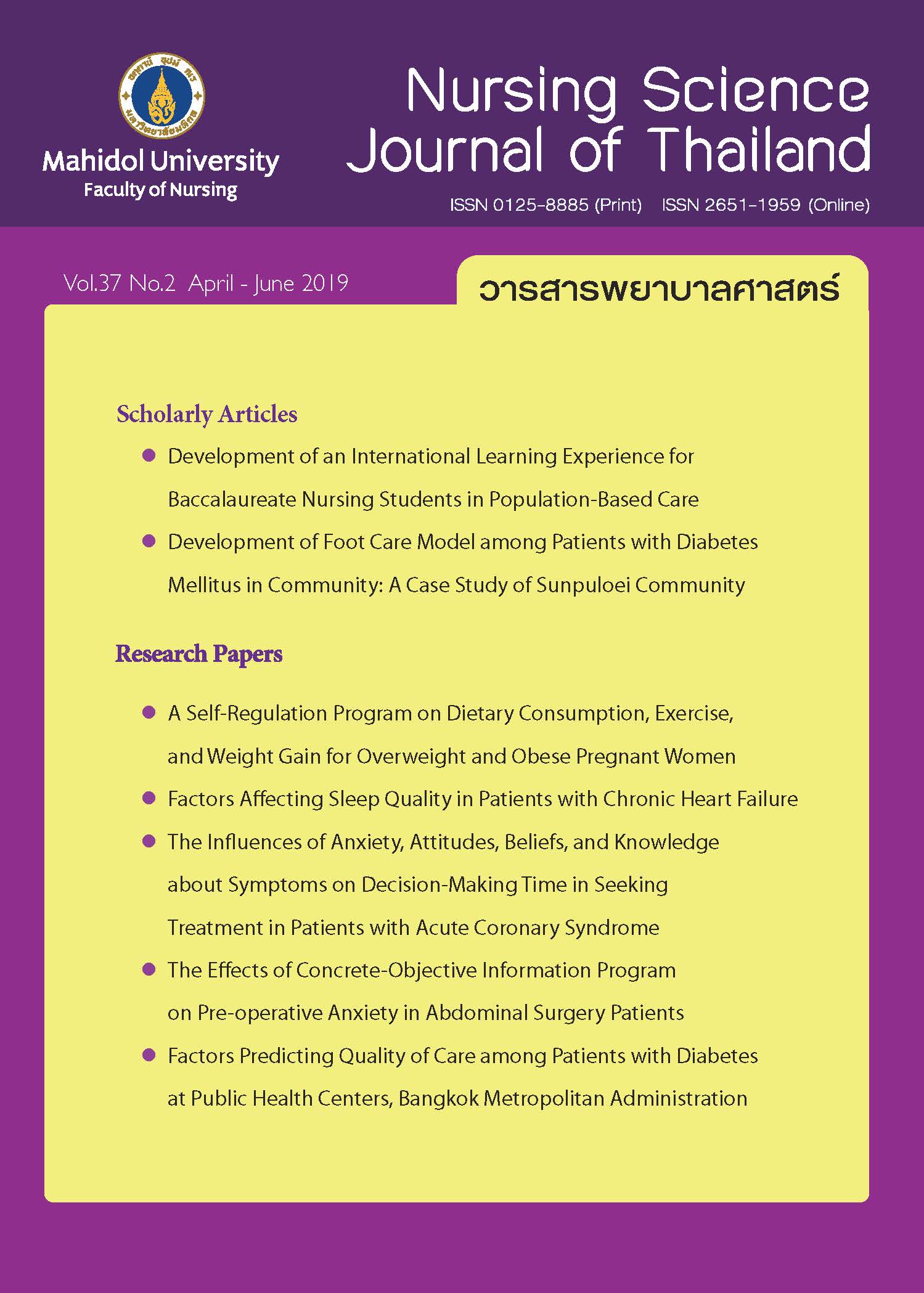Development of Foot Care Model among Patients with Diabetes Mellitus in Community A Case Study of Sunpuloei Community
Main Article Content
Abstract
Diabetic foot ulcers are major complication leading to foot amputation in patients with diabetes mellitus. Such complication adversely affects the patients both physically and mentally resulting in reduced quality of life and increased family care burden. Diabetes foot care in community is important to prevent ulcers and reduce complications in diabetic foot ulcers that lead to amputation. This paper aimed to share lesson learned from the development of foot care model among patients with diabetes mellitus in Sunpuloei community, Chiang Mai Province. Using research and development process, the project was composed of 2 phases. The first phase consisted of a situational analysis, a development of model, and a tryout of the foot care model. The second phase was to investigate the effect of the foot care model on diabetes patients’ foot care behavior. The result revealed that the experimental group significantly showed better foot care behaviors than did the control group. The foot care model developed for patients with diabetes mellitus at Sunpuloei community was effective and should be encouraged for use in other communities. The process of model development implemented could also be an exemplar for other communities to learn and follow.
Article Details
Copyright Notice: Nursing Science Journal of Thailand has exclusive rights to publish and distribute the manuscript and all contents therein. Without the journal’s permission, the dissemination of the manuscript in another journal or online, and the reproduction of the manuscript for non-educational purpose are prohibited.

Disclaimer: The opinion expressed and figures provided in this journal, NSJT, are the sole responsibility of the authors. The editorial board bears no responsibility in this regard.
References
2. Ogurtsova K, Fernandes R, Huang Y, Linnenkamp U, Guariguata L, Cho NH. IDF diabetes atlas: global estimates for the prevalence of diabetes for 2015 and 2040. Diabetes Res Clin Pract. 2017;128:40-50.
3. Srichang N. Prediction of Type 2 Diabetes Population in Thailand, 2011-2020. Weekly Epidemiological Surveillance Report. 2010;41(39):622-4. (in Thai).
4. Kosachunhanun N. Pathophysiology of diabetic foot diseases. In: Kosachunhanun N, editor. Prevention and management of the diabetic foot. Bangkok: Trick Think; 2013. p.21-34. (in Thai).
5. Moakes, H. An overview of foot ulceration in older people with diabetes. Nurs Older People. 2012;24(7):14-9.
6. Thirapatarapong W, Srisawasdi G. Epidemiology and direct costs of diabetes related lower extremity amputations at Siriraj Hospital. Journal of Thai Rehabilitation Medicine. 2008;18(2):65-9. (in Thai).
7. Srisomthrong K, Chintanawat R, Sucamvang K. Effect of self-Management support on foot care behaviors among older persons with type 2 diabetes mellitus. Thai Journal of Nursing Council. 2017;32(3):120-34. (in Thai).
8. Moungkum S. Nurses’ role in diabetic foot care. Journal of The Royal Thai Army Nurses. 2017;18 Suppl:1-10. (in Thai).
9. Chiang Mai Provincial Public Health Office. DATA SET of Diabetic in Chiang Mai Province [Mimeograph]. Chiang Mai: Chiang Mai Provincial Public Health Office; 2016. (in Thai).
10. Institute of Medical Technology Assessment and Evaluation, Department of Medical Services, Ministry of Public Health. Factsheet for diabetes/hypertension and complication in Thailand. Nonthaburi: Ministry of Public Health; 2013. (in Thai).
11. Boulton AJ, Vilkeite L, Ragnarson-Tennall G, Apelqvist J. The global burden of diabetic foot disease. Lancet. 2005;366(9498):1719-24.
12. Pitchalard K, Reangsing C, Moonpanane K. Development of type 2 diabetes preventive model for diabetic risk group in community, Chiang Rai Province. Journal of Nursing Science, Chulalongkorn University. 2016;28(3):132-46. (in Thai).
13. Sub-district Health Promoting Hospital, Ban Kok Mon. Annual-report-foot exam-2015. Chiang Mai: Sub-district Health Promoting Hospital, Ban Kok Mon; 2016. p.25-6. (in Thai).
14. Winitsorn N, Tangchitmeti P, Yuenyong N, Panbun S. The development of chronic care model for urban older adults by community participation: a case study of Bangkhayaeng Community, Mueang District, Pathum Thani Province. Journal of Nursing and Education. 2015;8(3):14-32. (in Thai).


